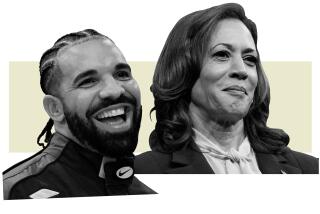New faces among black studies scholars
- Share via
CHICAGO — Shawn Alexander can recognize the look immediately. It’s one of surprise when a student enters his African American studies class and finds, standing at the front, a white guy.
“Years ago, it happened more,” said Alexander, 38, who teaches at the University of Kansas. “I’d see the kids walk into my room, look down at their registration cards and up at me, and then walk out to make sure they had the right classroom.”
Around the country this year, college campuses are celebrating the 40th anniversary of African American studies programs. Although blacks make up the majority of the faculty, white scholars increasingly are making their mark.
It may be the ultimate in inclusion, as well as irony, in a discipline that emerged out of the Black Power movement of the late 1960s to challenge the white status quo.
White scholars have pursued doctorates in African American history in relatively large numbers. But whites with doctorates in black studies -- as well as those who teach in the field -- remain fairly rare.
Martha Biondi, an associate professor of African American studies and history at Northwestern University, said she thought her racially mixed group of students placed far more stock in her passion for her craft than in the fact that she’s white.
“There probably are students who wouldn’t enroll in a black studies course with a white professor,” said Biondi, 44, whose doctorate is in African American history. “But it’s my view that students are incredibly open-minded. They may at first say, ‘I wonder if this person is qualified,’ but students want a teacher who performs well, and, at the end of the day, that’s how they’ll judge you.”
Biondi was raised in a predominantly white town in Connecticut. She remembers being against President Nixon when she was in the third grade, watching black news affairs programs on television and reading her baby-sitter’s copies of “The Nation.” As a teen, she aspired to become a civil rights lawyer.
“Early on, I found the 1960s movements to be very vibrant, particularly the ideas of democracy and equality and freedom,” Biondi said.
African American studies programs emerged as more black students arrived on college campuses in the 1960s and encountered racism. They believed universities could help by adding more black professors along with courses that reflected their experiences and sensibilities.
The first program began in 1969 at San Francisco State.
“We were uniting the academy with the street,” said Nathan Hare, who headed the department. “We wanted to elevate black scholarship, but it wasn’t like no white person could touch it. Just like it wasn’t like black students should only take black studies courses.”
By 1973 nearly all of the country’s major universities had a black studies program, but the transition was less than smooth.
When Mark D. Naison began teaching at New York’s Fordham University in 1970, he didn’t just encounter skepticism about a Jewish guy teaching in the discipline.
“There was a group of Black Nationalist students who completely rejected me doing this,” said Naison, 60, who wrote about the experience in his book “White Boy: A Memoir.” “I wasn’t who they had fought for, and they would try to stare me down. I grew up in Brooklyn; I’m not a small person. I stared back.”
Naison has used rap music to teach history (he goes by the name “Notorious PhD”) and appeared on comedian Dave Chappelle’s TV show flaunting his knowledge of black history. But Naison said he’s sensitive to his place as a member of the majority who’s in a profession where he’s a minority.
“I refused to be department chair until I was there nearly 20 years,” Naison said. He did chair the department in the early 1990s and will do so again in the fall.
At Northwestern, Tom Edge is part of the newest generation of white professors entering the field. Edge, 33, received his doctorate in African American studies in May from the University of Massachusetts.
What’s changed most dramatically in the discipline over 40 years is the student body, which is far more racially diverse.
Edge said that although he’s had a positive experience in the classroom, he has faced some pushback from friends.
“If you’re white and studying black culture, then you must be in the midst of some identity crisis,” he said.
Edge was drawn to black studies as he began to learn just how much had been omitted from history class at his New Jersey high school.
“Almost always it’s my white students who ask me how I became interested in the field,” Edge said. “Many of them have learned history the way I did, and when they see how black history fits in, they begin to understand its richness.”
A visiting professor this year, Edge opted not to display his picture on the Web page of the black studies department.
“There are no expectations on how I’m going to do,” he said. “Instead, students judge me by what’s going on in the classroom. I do my best to present information to them as thoroughly as possible. They can see how much I love doing this, and that’s more important than anything else.”
--
More to Read
Sign up for Essential California
The most important California stories and recommendations in your inbox every morning.
You may occasionally receive promotional content from the Los Angeles Times.













